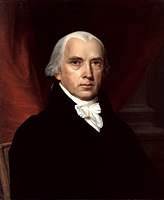
KNOWPIA
WELCOME TO KNOWPIA
Summary
The 1812 United States presidential election in Pennsylvania took place as part of the 1812 United States presidential election. Voters chose 25 representatives, or electors to the Electoral College,[1] who voted for President and Vice President.
| |||||||||||||||||||||||||||||
| |||||||||||||||||||||||||||||

| |||||||||||||||||||||||||||||
| |||||||||||||||||||||||||||||
Pennsylvania voted for the Democratic-Republican candidate, James Madison, over the Federalist candidate, DeWitt Clinton. Madison won Pennsylvania by a margin of 25.2%. Pennsylvania was the tipping-point state this election.
Results edit
| 1812 United States presidential election in Pennsylvania[2] | |||||
|---|---|---|---|---|---|
| Party | Candidate | Votes | Percentage | Electoral votes | |
| Democratic-Republican | James Madison (incumbent) | 48,816 | 62.60% | 25 | |
| Federalist | DeWitt Clinton | 29,162 | 37.40% | 0 | |
| Totals | 77,978 | 100.0% | 25 | ||
Note: Election results totals only include known numbers, as verified by the source. Vote totals from several counties are missing/unknown.
County results edit
| County | James Madison
Democratic-Republican |
DeWitt Clinton
Federalist |
Total votes cast | ||
|---|---|---|---|---|---|
| % | # | % | # | ||
| Adams | 35.47% | 410 | 64.53% | 746 | 1,156 |
| Allegheny | 59.96% | 966 | 40.04% | 645 | 1,611 |
| Armstrong | 70.35% | 121 | 29.65% | 51 | 172 |
| Beaver[3] | 62.37% | 383 | 37.62% | 231 | 614 |
| Bedford | 56.20% | 721 | 43.80% | 562 | 1,283 |
| Berks | 81.36% | 3,025 | 18.64% | 693 | 3,718 |
| Bucks | 49.03% | 2,184 | 50.97% | 2,270 | 4,454 |
| Butler | 79.96% | 375 | 20.04% | 94 | 469 |
| Cambria | 64.03% | 89 | 35.97% | 50 | 139 |
| Centre | 85.33% | 1,239 | 14.67% | 213 | 1,452 |
| Chester | 47.28% | 2,788 | 52.72% | 3,109 | 5,897 |
| Crawford | 74.64% | 2,455 | 25.36% | 834 | 3,289 |
| Cumberland | 63.29% | 269 | 36.71% | 156 | 425 |
| Dauphin | 77.10% | 1,842 | 22.90% | 547 | 2,389 |
| Dauphin (late return) | 95.56% | 86 | 4.44% | 4 | 90 |
| Delaware | 32.58% | 592 | 67.42% | 1,225 | 1,817 |
| Erie | 54.09% | 152 | 45.91% | 129 | 281 |
| Fayette | 83.60% | 999 | 16.40% | 196 | 1,195 |
| Franklin | 66.89% | 1,513 | 33.11% | 749 | 2,262 |
| Greene | 64.98% | 425 | 35.02% | 229 | 654 |
| Huntingdon | 51.11% | 712 | 48.89% | 681 | 1,393 |
| Indiana[3] | 62.27% | 137 | 37.73% | 83 | 220 |
| Lancaster | 39.32% | 2,438 | 60.68% | 3,762 | 6,200 |
| Lehigh | 82.53% | 1,039 | 17.47% | 220 | 1,259 |
| Luzerne | 36.41% | 713 | 63.59% | 1,245 | 1,958 |
| Lycoming | 72.38% | 933 | 27.62% | 356 | 1,289 |
| Mercer | 79.27% | 367 | 20.73% | 96 | 463 |
| Mifflin | 89.54% | 1,053 | 10.46% | 123 | 1,176 |
| Montgomery | 59.12% | 2,623 | 40.88% | 1,814 | 4,437 |
| Northampton | 80.10% | 1,554 | 19.90% | 386 | 1,940 |
| Northumberland | 85.14% | 3,415 | 14.86% | 596 | 4,011 |
| Philadelphia | 60.11% | 6,987 | 39.89% | 4,637 | 11,624 |
| Susquehanna | 82.76% | 725 | 17.24% | 151 | 876 |
| Somerset | 71.89% | 422 | 28.11% | 165 | 587 |
| Venango & Warren | 78.44% | 131 | 21.56% | 36 | 167 |
| Washington | 84.57% | 2,334 | 15.43% | 426 | 2,760 |
| Wayne | 74.44% | 297 | 25.56% | 102 | 399 |
| Westmoreland | 63.96% | 818 | 36.04% | 461 | 1,279 |
| York | 59.77% | 2,090 | 40.23% | 1,407 | 3,497 |
| Source: [2] | |||||
See also edit
Notes edit
- ^ While commonly labeled as the Federalist candidate, Clinton technically ran as a Democratic-Republican and was not nominated by the Federalist party itself, the latter simply deciding not to field a candidate. This did not prevent endorsements from state Federalist parties (such as in Pennsylvania), but he received the endorsement from the New York state Democratic-Republicans as well.
References edit




